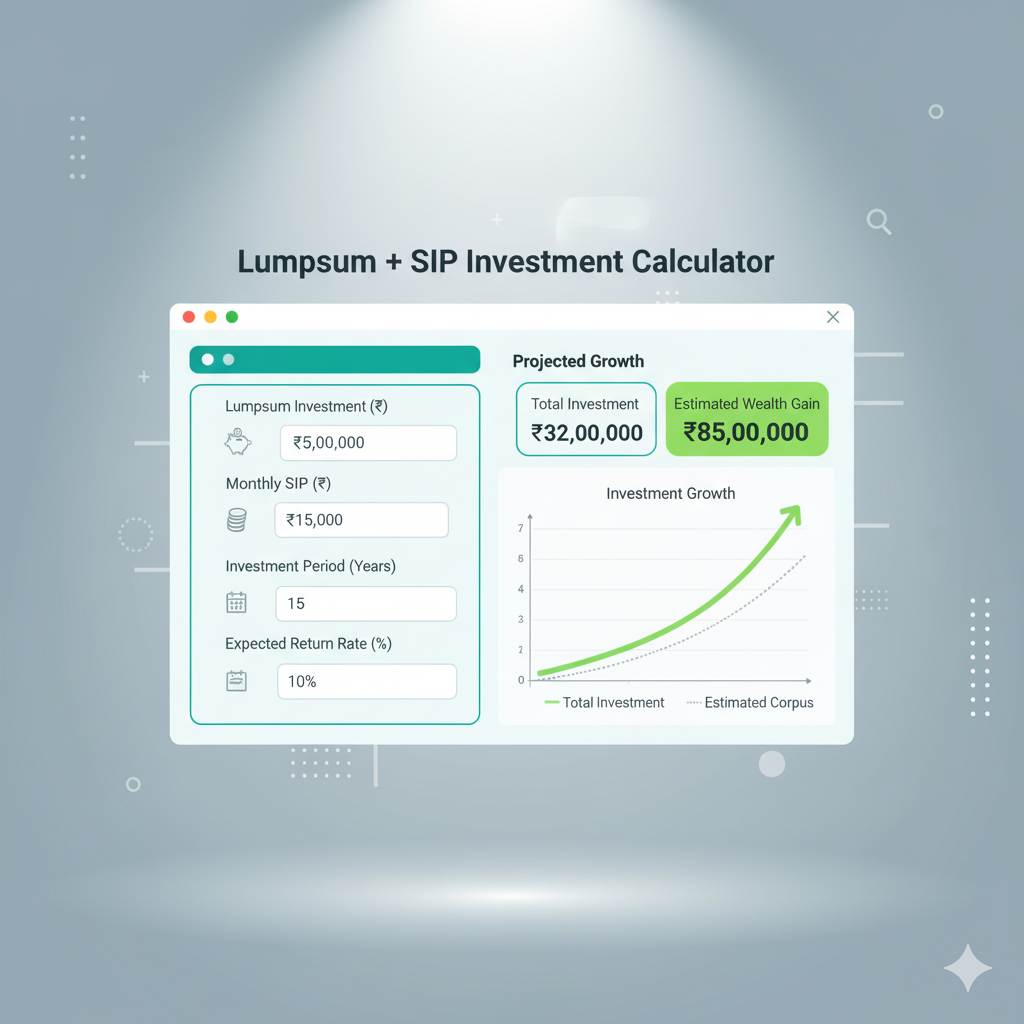Lumpsum + SIP Calculator Excel
Calculate and compare Lump Sum & SIP investments
Results are estimates only. Actual values may vary based on market conditions.
Managing your money these days feels more complex than ever, with so many investment options out there. People often find it tough to figure out how their savings will grow in different plans. Two popular strategies—Lumpsum + SIP Calculator Excel investing and Systematic Investment Plans (SIPs)—get compared a lot by folks looking to maximize their returns. While there are plenty of online calculators, many investors love using spreadsheets for that extra flexibility.
That’s where a Lumpsum + SIP Calculator Excel comes in as a real game-changer.By putting both methods into one simple Excel sheet, you get more control over your projections, tweaks, and long-term plans. Let’s dive into why this is such a powerful tool, how it actually works, and why Excel is still a go-to for personal finance.
The Growing Popularity of Investment Calculators in Excel
Digital tools have made it super easy to predict returns and map out your financial goals. But not everyone wants to stick with web-based apps. Excel calculators bridge that gap—they’re customizable, simple to edit, and you can save them for later use.
For those who value transparency, Excel lays it all out: you see exactly how the math is done. Unlike those mysterious online calculators, a spreadsheet breaks down the formulas step by step. This builds real confidence, especially when dealing with big chunks of cash.
Having SIP and lumpsum calculations side by side in one sheet makes decisions way easier by letting you compare them directly.
Understanding Lumpsum + SIP Calculator Excel: The Core Difference
To really get why an Excel calculator is so handy, it’s key to grasp what sets these two investment styles apart.
- A lumpsum investment means dumping a big amount in all at once. Your money starts compounding right away, and if the market plays nice, you could see some serious growth.
- A Systematic Investment Plan (SIP), though, lets you chip in smaller amounts regularly—like monthly or quarterly. This smooths out market ups and downs through something called rupee-cost averaging.
Both have their upsides. The big question isn’t picking one or the other, but how to mix them for the best results. That’s exactly where a Lumpsum + SIP Calculator Excel shines, giving you those clear side-by-side views.
Why Use Excel for Investment Planning?
Excel isn’t just for crunching numbers—it’s a powerhouse for financial modeling. Here’s why so many investors turn to it for their calculators:
- Transparency: Every formula is right there for you to check and understand.
- Flexibility: You can add custom stuff like inflation tweaks, tax breaks, or changing SIP amounts.
- Scenario Testing: Play around with different assumptions—like interest rates, time frames, or investment sizes—and see the impact instantly.
- Portability: Once it’s set up, you can use it offline anytime, no internet needed.
Unlike rigid online tools, Excel lets you own your financial model and tweak it as your life changes.
Building a Lumpsum + SIP Calculator in Excel
The formulas can get as fancy as you want, but the basic setup usually includes:
- An input area for your lumpsum amount, monthly SIP contribution, expected return rate, and how long you’ll invest.
- A formula to compound the lumpsum over that period.
- A repeating calculation for SIP growth, applying returns to each installment up to the end.
- A summary that shows your final amount, total invested, and the gains.
The cool part about Excel? You can build on this—add charts to see growth visually, factor in inflation, or even track multiple funds in separate columns.
The Role of Compounding in Both Strategies
Compounding is the magic behind building wealth. Whether you’re going Lumpsum + SIP Calculator Excel or SIP, earning returns on your principal plus the gains is what makes it grow.
In lumpsum, compounding kicks in on the whole amount from day one, often leading to bigger wins over time. With SIPs, it builds up gradually as each contribution adds to the pot.
An Excel calculator makes this crystal clear by graphing how compounding differs over the same timeline. It really drives home why time in the market matters most, no matter the approach.
Using the Calculator for Real-Life Scenarios
What makes an Excel Lumpsum + SIP Calculator Excel so great is how it fits your personal life.
- A young investor might check how a modest monthly SIP plus bonus Lumpsum + SIP Calculator Excel could grow over 15 years.
- Parents could model a Lumpsum + SIP Calculator Excel now with ongoing SIPs to cover kids’ education in a decade.
- Someone close to retirement might compare a big one-time investment against steady SIPs.
Tinkering with scenarios helps you craft a plan that matches your income and goals.
Comparing Risk Profiles Through Excel Calculations
Markets fluctuate, and that hits Lumpsum + SIP Calculator Excel and SIP differently. Lumpsum + SIP Calculator Excel folks risk buying at a high point, which might slow things down. SIP investors spread it out with rupee-cost averaging, lowering the overall risk.
In Excel, you can simulate this by tweaking return rates—like a safe 6% vs. a bold 12%. It shows how strategies hold up in different markets, helping you pick one that fits your comfort level.
Advantages of Combining Lumpsum + SIP Calculator Excel Sheet
Merging both in one calculator brings some solid perks:
- Easy comparisons without flipping between tools.
- Room to test hybrids, like a lumpsum start followed by monthly SIPs.
- Boosts your financial know-how by showing how they work together, not against each other.
In the end, it lets you build a portfolio that leverages quick compounding and steady habits.
Inflation and Real Returns in Excel Calculations
Inflation is a sneaky thing that many calculators skip. Sure, raw returns look great, but rising prices can eat into what you can actually buy.
In Excel, you fix this with a simple inflation formula. Plug in something like 5% yearly, and it shows not just the nominal total but the real value. That gives a truer sense of your future wealth.
How Financial Planners Use Excel Models
It’s not only DIY investors—financial pros love customized Excel sheets to show clients the ropes. Unlike generic online stuff, these can be tailored for things like taxes, SIP schedules, or goal-based saving.
Presenting in Excel with tables, charts, and comparisons makes it engaging and trustworthy, turning advice into a clear conversation.
Common Mistakes to Avoid When Using Excel Calculators
Excel is awesome, but slip-ups happen if formulas aren’t spot-on. A tiny error in a bracket or cell can throw everything off.
People often pick unrealistically high returns—like 15%—when 8-10% is more grounded for mutual funds.
Don’t forget inflation or taxes either; skipping them makes projections look better than reality.
Excel vs Online Calculators: Which is Better?
Both have their place. Online ones are fast and newbie-friendly. But they can feel limited.
For serious planning, Excel wins with its depth, custom options, and record-keeping. It’s perfect for detailed scenarios and personal tweaks.
FAQs on Lumpsum + SIP Calculator Excel
Final Thoughts
A Lumpsum + SIP Calculator Excel is way more than a sheet—it’s your financial guide. By mixing both styles, you can test, compare, and choose smartly.It spotlights compounding, shows inflation’s bite, and offers flexibility online tools can’t match. For newbies, it’s a learning tool; for pros, it’s strategy central.In the end, Excel puts you in the driver’s seat of your finances. With this calculator, you’re not just guessing future wealth—you’re building confidence in your choices for tomorrow.

